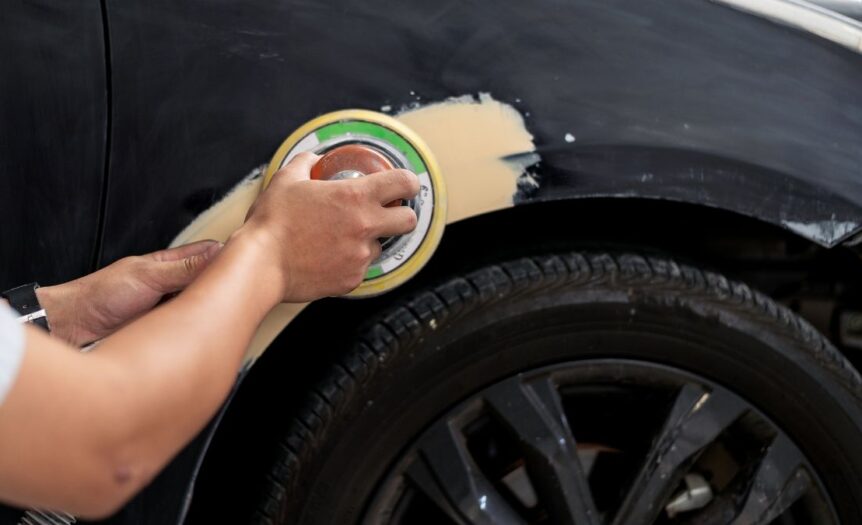Automobile painting is an art, and it requires a lot of effort if you want to achieve the perfect finish on your car. One of the essential tools required in automobile painting is sanding discs. These discs are crucial to smooth out irregularities and imperfections on a car’s surface before painting.
However, you might damage your vehicle’s surface if you don’t know how to use sanding discs correctly. Let’s look at some tips on how to use sanding discs correctly for automobile painting.
Choose the Right Sanding Discs
Different types of sanding discs are available on the market that are designed to work on specific surfaces. Therefore
, choosing the right sanding disc for the type of surface you want to work on is crucial. For example, if you want to work on a metal surface, you should choose sanding discs designed for metal surfaces. Using the wrong sanding discs can damage your car’s surface, so it’s crucial that you choose the right one.
Choose the Right Grit
The grit level plays an important role in achieving the desired finish in automobile painting. The grit level determines how coarse or fine a sanding disc is and affects how much material it can remove per pass. Using the wrong grit level means you will either not remove any material from the service or will cause excessive material and damage your vehicle’s surface. If you’re working on a rough surface, start with a coarse-grit sanding disc and gradually move to finer grits. If you’re unsure what grit level to use, start with a medium grit level and make adjustments as necessary.
Keep the Surface Wet
Wet sanding is a technique used in automobile painting that involves keeping the surface you’re working on wet while sanding. Wet sanding helps prevent the sanding disc from clogging up and reduces the risk of scratching the surface. It is also helpful reduce dust and residue that can cause damage to the car’s paint.
Use the Right Pressure
Using the right pressure is another important factor you need to consider in order to achieve your desired finish. Applying too much pressure can damage the vehicle’s surface, while too little pressure may not remove enough material. Start with light pressure and gradually increase it as necessary, watching the surface to avoid damage.
Sand in One Direction
Sanding in one direction helps to avoid any unnecessary scratches and ensures a smoother finish. It is also important to keep your sanding disc moving over the surface rather than letting it stay in one spot for too long. This movement will help create an even finish and prevent any imperfections in the paint job.
Using sanding discs correctly can help you achieve a smooth and flawless finish on your car when painting. Sanding discs are just one of the main types of automotive abrasives essential for achieving the perfect finish. Just follow these tips on using sanding discs correctly, and you’ll be well on your way to creating a professional-looking paint job.










 Deering Estate
Deering Estate
 Massage Envy South Miami
Massage Envy South Miami
 Calla Blow Dry
Calla Blow Dry
 My Derma Clinic
My Derma Clinic
 Sushi Maki
Sushi Maki
 Sports Grill
Sports Grill
 The Healthy Kitchen
The Healthy Kitchen
 Golden Rule Seafood
Golden Rule Seafood
 Malanga Cuban Café
Malanga Cuban Café

 Kathleen Ballard
Kathleen Ballard
 Panter, Panter & Sampedro
Panter, Panter & Sampedro
 Vintage Liquors
Vintage Liquors
 The Dog from Ipanema
The Dog from Ipanema
 Rubinstein Family Chiropractic
Rubinstein Family Chiropractic
 Your Pet’s Best
Your Pet’s Best
 Indigo Republic
Indigo Republic




 ATR Luxury Homes
ATR Luxury Homes


 2112 Design Studio
2112 Design Studio
 Hamilton Fox & Company
Hamilton Fox & Company
 Creative Design Services
Creative Design Services
 Best Pest Professionals
Best Pest Professionals
 HD Tree Services
HD Tree Services
 Trinity Air Conditioning Company
Trinity Air Conditioning Company
 Cisca Construction & Development
Cisca Construction & Development
 Mosquito Joe
Mosquito Joe
 Cutler Bay Solar Solutions
Cutler Bay Solar Solutions


 Miami Royal Ballet & Dance
Miami Royal Ballet & Dance
 Christopher Columbus
Christopher Columbus
 Pineview Preschools
Pineview Preschools
 Westminster
Westminster
 Carrollton
Carrollton
 Lil’ Jungle
Lil’ Jungle
 Frost Science Museum
Frost Science Museum
 Palmer Trinity School
Palmer Trinity School
 South Florida Music
South Florida Music
 Pinecrest Orthodontics
Pinecrest Orthodontics
 Dr. Bob Pediatric Dentist
Dr. Bob Pediatric Dentist
 d.pediatrics
d.pediatrics
 South Miami Women’s Health
South Miami Women’s Health

 The Spot Barbershop
The Spot Barbershop
 My Derma Clinic
My Derma Clinic




 Miami Dance Project
Miami Dance Project

 Rubinstein Family Chiropractic
Rubinstein Family Chiropractic
 Indigo Republic
Indigo Republic

 Safes Universe
Safes Universe
 Vintage Liquors
Vintage Liquors
 Evenings Delight
Evenings Delight





 Atchana’s Homegrown Thai
Atchana’s Homegrown Thai
 Baptist Health South Florida
Baptist Health South Florida

 Laser Eye Center of Miami
Laser Eye Center of Miami
 Visiting Angels
Visiting Angels
 OpusCare of South Florida
OpusCare of South Florida

 Your Pet’s Best
Your Pet’s Best





 HD Tree Services
HD Tree Services
 Hamilton Fox & Company
Hamilton Fox & Company


 Creative Design Services
Creative Design Services